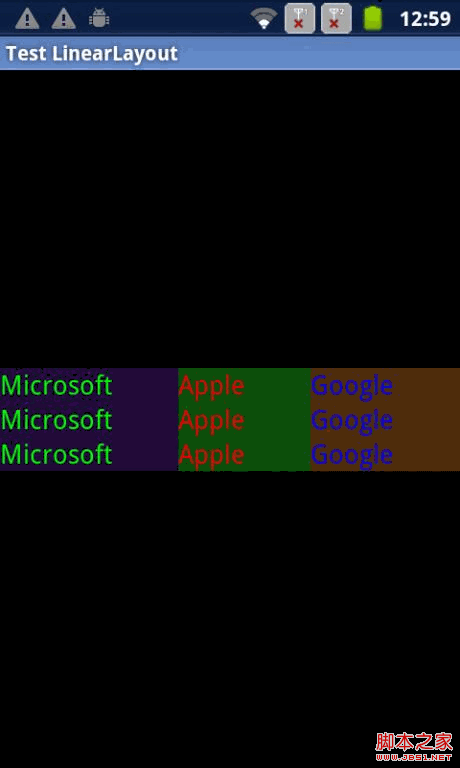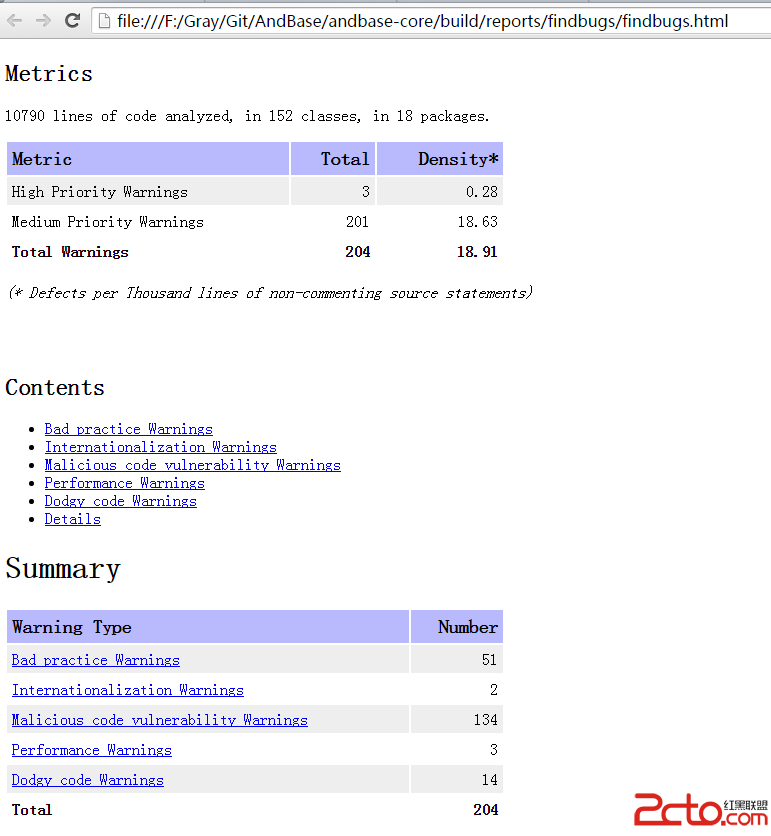編輯:關於Android編程

代碼如下:
復制代碼 代碼如下:
<?xml version="1.0" encoding="utf-8"?>
<LinearLayout xmlns:android="http://schemas.android.com/apk/res/android"
android:orientation="vertical"
android:layout_width="fill_parent"
android:layout_height="fill_parent"
android:gravity="center"
>
<LinearLayout
android:id="@+id/linearlayout_test_1"
android:layout_width="fill_parent"
android:layout_height="wrap_content">
<TextView
android:layout_width="wrap_content"
android:layout_height="wrap_content"
android:textColor="#ff00ff00"
android:background="#aa331155"
android:layout_weight="1"
android:textSize="18sp"
android:text="Microsoft"
/>
<TextView
android:layout_width="wrap_content"
android:layout_height="wrap_content"
android:textColor="#ffff0000"
android:background="#aa117711"
android:layout_weight="1"
android:textSize="18sp"
android:text="Apple"
/>
<TextView
android:layout_width="wrap_content"
android:layout_height="wrap_content"
android:textColor="#ff0000ff"
android:background="#aa774411"
android:layout_weight="1"
android:textSize="18sp"
android:text="Google"
/>
</LinearLayout>
<LinearLayout
android:id="@+id/linearlayout_test_2"
android:layout_width="fill_parent"
android:layout_height="wrap_content">
<TextView
android:layout_width="wrap_content"
android:layout_height="wrap_content"
android:textColor="#ff00ff00"
android:background="#aa331155"
android:layout_weight="1"
android:textSize="18sp"
android:text="Microsoft"
/>
<TextView
android:layout_width="wrap_content"
android:layout_height="wrap_content"
android:textColor="#ffff0000"
android:background="#aa117711"
android:layout_weight="1"
android:textSize="18sp"
android:text="Apple"
/>
<TextView
android:layout_width="wrap_content"
android:layout_height="wrap_content"
android:textColor="#ff0000ff"
android:background="#aa774411"
android:layout_weight="1"
android:textSize="18sp"
android:text="Google"
/>
</LinearLayout>
<LinearLayout
android:id="@+id/linearlayout_test_3"
android:layout_width="fill_parent"
android:layout_height="wrap_content">
<TextView
android:layout_width="wrap_content"
android:layout_height="wrap_content"
android:textColor="#ff00ff00"
android:background="#aa331155"
android:layout_weight="1"
android:textSize="18sp"
android:text="Microsoft"
/>
<TextView
android:layout_width="wrap_content"
android:layout_height="wrap_content"
android:textColor="#ffff0000"
android:background="#aa117711"
android:layout_weight="1"
android:textSize="18sp"
android:text="Apple"
/>
<TextView
android:layout_width="wrap_content"
android:layout_height="wrap_content"
android:textColor="#ff0000ff"
android:background="#aa774411"
android:layout_weight="1"
android:textSize="18sp"
android:text="Google"
/>
</LinearLayout>
</LinearLayout>
和:
復制代碼 代碼如下:
package com.android.explorer;
import android.app.Activity;
import android.os.Bundle;
import android.widget.LinearLayout;
public class LinearLayoutTest extends Activity {
@Override
public void onCreate(Bundle savedInstanceState) {
super.onCreate(savedInstanceState);
setContentView(R.layout.linearlayout_test);
LinearLayout one = (LinearLayout) findViewById(R.id.linearlayout_test_1);
one.setOrientation(2012);
LinearLayout two = (LinearLayout) findViewById(R.id.linearlayout_test_2);
two.setOrientation(Integer.MAX_VALUE);
LinearLayout three = (LinearLayout) findViewById(R.id.linearlayout_test_3);
three.setOrientation(Integer.MIN_VALUE);
}
}
用Enum代替整數集
其實很簡單,用Enum(枚舉)就可以很方便的解決這個問題,使用起來也不比定義整數集繁瑣,同樣的可讀。另外的優點就是,它的封裝更好,最重要的是它會在編譯時被檢查。因為Java是一種Strong Type,也就是說在編譯時,編譯器會對所有原型類型和參數類型進行檢查,如果類型不對,並且沒有強制轉型的,就會報出編譯錯誤,當然編譯器所支持的自動轉型除外。比如一個需要int,而傳的參數是long,雖然都差不多,沒有溢出等,但還是會有編譯錯誤。
所以,如果LinearLayout使用Enum,就像這樣定義:
復制代碼 代碼如下:
public class LinearLayout extends ViewGroup {
private Orientation mOrientation;
public enum Orientation {
HORIZONTAL, VERTICAL
};
public void setOrientation(Orientation dir) {
mOrientation = dir;
}
}
然後這樣使用:
復制代碼 代碼如下:
import android.widget.LinearLayout;
LinearLayout.setOrientation(Orientation.HORIZONTAL);
LinearLayout.setOrientation(Orientation.VERTICAL);
那麼,開發者就不會用錯了,因為首先,它看到setOrientation所需要的參數是一個Orientation的枚舉類型,就會自然的傳送Orientation中定義的類型;另外,如果傳其他的值,比如0或者1,編譯器也不會答應的。
可悲的是Android中幾乎所有的API都是以整數集的方式來定義的,所以就要時刻提醒自己和組裡的人,一定要傳所定義的整數集中的常量。
那麼我們能做的,除了要傳整數集中定義的常量,對於那些以整數集方式定義的API,以外。更重要的是當自己定義接口的時候,盡量用Enum而不要使用整數集。
還有一點需要注意的是,對於某些弱類型語言,也就是說在編譯時不會對類型做特別細致的檢查,比如C++,C等,那麼即使使用了Enum,也不一定安全,因為對於C++和C來講Enum中的常量與整數常量完全一樣,連編譯器都分不清。所以,對於這類語言,只能寄希望於開發者了。
後記:
寫完這篇,讓我想起了另外一些與參數定義相關的問題,比如布爾型參數也不是一個很好的設計,因為使用者很難到底應該傳True還是傳False,特別是當方法名字不能體現Boolean參數作用時和文檔不夠清楚的時候。如果只有一個參數還好,根據方法名字和常識都能知道,比如:
復制代碼 代碼如下:
Button.setEnabled(true); // enable the button
Button.setEnabled(false); // disable the button
但對於某些情況,當方法的名字不能體現Boolean參數的作用時,或是多於一個參數時,而方法的主要目的又不能體現Boolean參數的作用時,就很不清楚,比如:
復制代碼 代碼如下:
// com/android/mms/data/ContactList.java
public String[] getNumbers(boolean);
您能猜出來這個boolean變量是決定是否要為彩信對聯系人做特殊的處理嗎?您在使用這個API的時候能很快知道該傳True還是該傳False嗎?當讀到這些語句的時候:
復制代碼 代碼如下:
String[] mms = getNumbers(true);
String[] sms = getNumbers(false);
您能知道True和False的含義與作用嗎?至少我看到這樣的代碼時,如果不去跟蹤它的實現,是猜不出來的。
但現實的問題是,API通常又需要從調用者那裡得到做還是不做的決定。一個可行的途徑是用方法來封裝和隱藏,比如:
復制代碼 代碼如下:
Button.setEnabled(true); // enable the button
Button.setEnabled(false); // disable the button
可以改成:
復制代碼 代碼如下:
Button.enable();
Button.disable();
這是簡單的情況,對於稍復雜的情況,比如後一個例子,可以添加另外的接口,而不是用重載方法,但內部的實現,可能還是需要重載,但是這就把問題縮小了,起碼對使用者來說是隱藏的:
復制代碼 代碼如下:
// com/android/mms/data/ContactList.java
public String[] getNumbersForSms();
public String[] getNumbersForMms();
這樣一來,對外來講就是良好的封裝。內部實現可能還是需要一個類似這樣的私有方法:
復制代碼 代碼如下:
// com/android/mms/data/ContactList.java
public String[] getNumbersForSms() {
return getNumbers(false);
}
public String[] getNumbersForMms() {
return getNumbers(true);
}
private String[] getNumbers(boolean) {
// implementation
}
但至少把問題縮小化了,也可以加上注釋來說明。就不必導致使用者來猜方法的用法和含義了。
 Jenkins構建Android項目持續集成之findbugs的使用
Jenkins構建Android項目持續集成之findbugs的使用
題外話這篇本來和之前的系列要一起出的,但是因為中間公司要發布一個版本,給耽擱了,今天工作做完了,又閒了下來。所以就又來繼續jenkins構建Android項目持續集成系列
 UI控件之顯示圖像控件ImageView(下)
UI控件之顯示圖像控件ImageView(下)
(一)繪制最簡單的圓形ImageViewRoundedImageViewCircleImageView運行效果:實現代碼:自定義ImageView代碼:package c
 打造Android 最實用的ViewPager 指示器控件
打造Android 最實用的ViewPager 指示器控件
為什麼我說它是最實用的 ViewPager 指示器控件呢? 它有以下幾個特點: 1、通過自定義 View 來實現,代碼簡單易懂; 2、使用起來非常方便; 3、通用性高,大
 Android BottomNavigationView底部導航效果
Android BottomNavigationView底部導航效果
BottomNavigationView 很早之前就在 Material Design 中出現了,但是直到 Android Support Library 25 中才增加